Pas de biographie disponible.
Compositeur Musique additionelle Librettiste Parolier Metteur en scène Chorégraphe Producteur création Producteur version
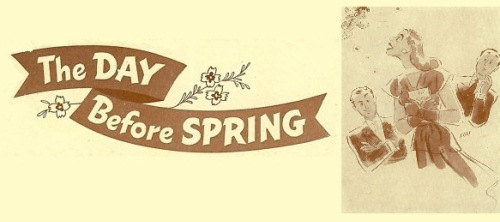
Musical
Musique: Frederik Loewe • Paroles: Alan Jay Lerner • Livret: Alan Jay Lerner • Production originale: 5 versions mentionnées
Dispo: Résumé Génèse Liste chansons
Genèse: The 1945 touring production closed in Chicago after three days due to a crippling coal strike. The show then opened at the Shubert Theatre, Boston, Massachusetts on October 30, 1945, with the Billboard Magazine critic writing "Lerner and Loewe look like potential supermen." The musical opened on Broadway on November 22, 1945 at the National Theatre, and closed on April 13, 1946 after 167 performances. Directed by Edward Padula and choreographed by Antony Tudor, the cast included Lucille Benson, John Archer, Bert Freed, Irene Manning, and William Johnson. The show was performed in July 2007 by the York Theatre Company in New York City as part of their Mufti Theatre series. The York staged concert starred Hunter Bell, Amanda Watkins, Richard Todd Adams, Edward Watts and Tia Speros. The restoration of the show was undertaken by musical supervisors Aaron Gandy, Mark York and director David Glenn Armstrong and included material that had been missing since the show closed on Broadway in 1946. A treasure trove of material was bought by the Library of Congress in 1999 which filled the missing holes in the score.
Résumé: The plot concerns a married woman who, at a college reunion, meets the man with whom she almost eloped ten years before. Romantically stirred by a novel he has written about her, she considers leaving her husband and reuniting with her former flame.
Création: 30/10/1945 - Shubert Theatre (Boston) - représ.
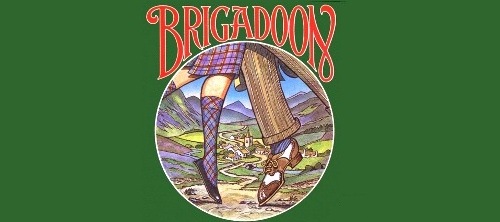
Musical
Musique: Frederik Loewe • Paroles: Alan Jay Lerner • Livret: Alan Jay Lerner • Production originale: 16 versions mentionnées
Dispo: Résumé Synopsis Génèse Liste chansons
Brigadoon is a musical with a book and lyrics by Alan Jay Lerner and music by Frederick Loewe. Songs from the musical, such as "Almost Like Being in Love" have become standards. It tells the story of a mysterious Scottish village that appears for only one day every hundred years, though to the villagers, the passing of each century seems no longer than one night. The enchantment is viewed by them as a blessing rather than a curse, for it saved the village from destruction. According to their covenant with God, no one from Brigadoon may ever leave, or the enchantment will be broken and the site and all its inhabitants will disappear into the mist forever. Two American tourists, lost in the Scottish Highlands, stumble upon the village just as a wedding is about to be celebrated, and their arrival has serious implications for the village's inhabitants. The original production opened on Broadway in 1947 and ran for 581 performances. Brigadoon then received a West End production opening in 1949 that ran for 685 performances, and many revivals followed. A 1954 film version starred Gene Kelly and Cyd Charisse. A 1966 television version starred Robert Goulet and Peter Falk.
Genèse: The critic George Jean Nathan wrote that Lerner's book was based on a much older German story by Friedrich Gerstäcker, later translated by Charles Brandon Schaeffer, about the mythical village of Germelshausen that fell under an evil magic curse. In 1947, memories of World War II were too fresh to present a German-themed musical on Broadway, so Lerner reimagined the story in Scotland, complete with kilts, bonnie lassies, bagpipes, Highland flings and "Heather on the Hill". However, in his memoirs, The Street Where I Live, Lerner denied that he had based the book on an older story. He writes that after New York Times critic George Nathan had accused him of stealing the plot the Times "called and offered me space to answer him, which I did, labelling the whole accusation as rubbish and documenting the developments of [the] play into the final product." He goes on to write, "Nevertheless, to this day chroniclers of the musical theater invariably state Brigadoon was based on a folk tale and give Nathan as their authority." Lerner's name for his imaginary locale was probably based on a well-known Scottish landmark, the Brig o' Doon (Bridge of Doon), in Alloway, Scotland, in the heart of Robert Burns country. According to Burns's poem "Tam o'Shanter", this 13th century stone bridge is where the legendary Tam o' Shanter fled on his horse Meg in order to escape from three witches who were chasing him. Other sources suggest that the fictional village's name was constructed from the Celtic word "briga", which means "town" (such as in the old city names of Segobriga and Brigantium) and the Scottish Gaelic "dùn", which means a fort, e.g., Dundee or Dunfermline. The name may also be a reference to the Celtic Goddess Brigid, as in "Brigid's Hill". See also Alloway and D. Myers for another interpretation. Productions The original Broadway production, directed by Robert Lewis and choreographed by Agnes de Mille, opened March 13, 1947, at the Ziegfeld Theatre, where it ran for 581 performances. It starred David Brooks as Tommy, Marion Bell as Fiona, Lee Sullivan as Charlie, James Mitchell as Harry, and Pamela Britton as Meg. The concertmistress of the orchestra was noted American violinist Joan Field. De Mille won the Tony Award for Best Choreography, and Bell and Mitchell won the Theatre World Award. The production enjoyed an extended North American tour. The musical's original West End production opened on April 14, 1949, at Her Majesty's Theatre, running for 685 performances. It starred Philip Hanna as Tommy, Patricia Hughes as Fiona, James Jamieson as Harry, and Noele Gordon as Meg. The musical was revived at New York City Center in May 1950.[5] and returned to Broadway seven years later, directed by George H. Englund and choreographed by De Mille, opening on April 15, 1957, at the Adelphi Theatre, where it ran for 24 performances. The cast included David Atkinson, Helen Gallagher, Patricia Birch, and Marilyn Cooper. Another Broadway revival, directed by John Fearnley and choreographed by De Mille, opened on January 30, 1963, at New York City Center, where it ran for 16 performances. The cast included Peter Palmer, Russell Nype, Sally Ann Howes, and Edward Villella. It was Tony-nominated for Best Actress in a Musical (Howes), Best Direction of a Musical, and Best Conductor and Musical Director. The next Broadway revival, directed by Vivian Matalon and choreographed by De Mille, opened on October 16, 1980, at the Majestic Theatre, where it ran for 133 performances and eight previews. The cast included Meg Bussert, Martin Vidnovic, and John Curry. Vidnovic received Tony and Drama Desk Award nominations, Bussert earned a Tony nomination and won the Theatre World Award, and the production was Tony-nominated for Best Reproduction. New York City Opera has staged the musical in 1986 and 1991. The musical was revived in the West End at the Victoria Palace Theatre, opening on October 25, 1988, and closing August 5, 1989, starring Robert Meadmore (Tommy), Jacinta Mulcahy, and Lesley Mackie. The director was Roger Redfarn and de Mille's dances were rechoreographed by Tommy Shaw. The Times reviewer noted that those dances were "the main source of the magic."
Résumé: A Brigadoon, en Écosse, deux Américains rencontrent un village, frappé d'une malédiction qui le fait n'exister qu'un jour par siècle. Les habitants du village vivent donc au milieu du XVIIIe siècle. L'un des deux voyageurs, Tommy s'éprend d'une jeune habitante de ce village, Fiona. Celle-ci ne peut quitter le village pour l'accompagner à New-York où il vit : si un seul habitant du village s'éloigne, Brigadoon restera à jamais dans les ténèbres. De retour à New York, Tommy réalise que Brigadoon lui manque ; il repart aussitôt. Sur place, le village a disparu. Un miracle a lieu : Brigadoon émerge des brumes. Tommy retrouve Fiona et partagera le destin des habitants de Brigadoon.
Création: 13/3/1947 - Ziegfield Theatre (Broadway) - représ.
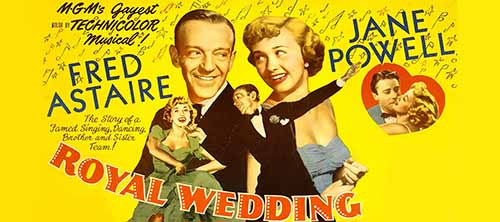
Film
Musique: Burton Lane • Paroles: Alan Jay Lerner • Livret: Alan Jay Lerner • Production originale: 1 version mentionnée
Dispo: Résumé
Genèse:
Résumé: Tom et Ellen Bowen sont frère et sœur et parmi les vedettes les plus populaires de Broadway. Ellen enchaîne les conquêtes qu'elle n'aime pas et Tom est un célibataire endurci. L'un comme l'autre éprouvent une sainte horreur à l'égard du mariage. Mais lors du voyage sur le bateau qui les emmène pour jouer à Londres, Ellen rencontre le playboy Lord John Brindale avec qui elle commence une romance qui devient rapidement plus sérieuse qu'ils ne l'avaient prévu. De son côté Tom tombe amoureux d'Anne Ashmond une danseuse anglaise qui auditionne pour le spectacle…
Création: 8/3/1951 - *** Film (***) - représ.
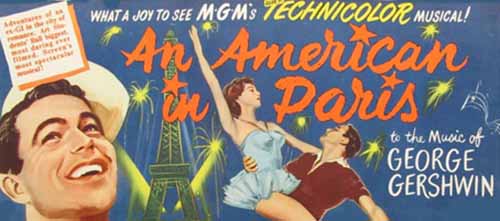
Film
Musique: George Gershwin • Paroles: Ira Gershwin • Livret: Alan Jay Lerner • Production originale: 1 version mentionnée
Dispo: Résumé
"An American in Paris" est une comédie musicale américaine cinématographique inspirée de la composition orchestrale "An American in Paris" de George Gershwin de 1928.
Genèse:
Résumé: À Paris, une riche héritière s'éprend de Jerry Mulligan (Gene Kelly), un jeune peintre américain. Mais celui-ci tombe amoureux de Lise (Leslie Caron), qui est elle-même promise à un autre homme, Henri. Ce film est universellement célèbre pour sa scène finale : Jerry pense qu'il ne pourra jamais être avec Lise et fait un rêve fantastique : apothéose du film. Il rêve qu'il danse avec Lise partout dans les rues de Paris. Le fiancé de la jeune fille et tout un chœur se joignent à eux tout au long d'un ballet magistral qui dure près de dix-huit minutes. La musique du ballet (qui porte le nom du film) est de George Gershwin. Dans les dernières mesures, Henri accepte de renoncer à Lise, qui se précipite dans les bras de Jerry sous la bénédiction d'Henri. Le film s'achève.
Création: 4/10/1951 - *** Film (***) - représ.
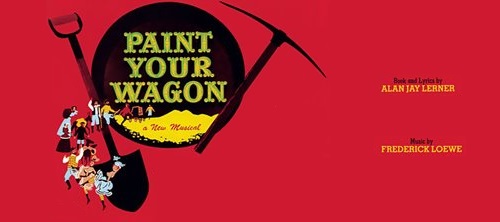
Musical
Musique: Frederik Loewe • Paroles: Alan Jay Lerner • Livret: Alan Jay Lerner • Production originale: 1 version mentionnée
Dispo: Résumé Synopsis Génèse Liste chansons
Genèse: The musical opened on Broadway at the Shubert Theatre on November 12, 1951, and closed on July 19, 1952, after 289 performances. The production was directed by Daniel Mann, set design by Oliver Smith, costume design by Motley, lighting design by Peggy Clark, music for dances arranged by Trude Rittman, with dances and musical ensembles by Agnes de Mille set to the orchestrations of Ted Royal. It starred James Barton (as Ben Rumson), Olga San Juan (Jennifer Rumson), Tony Bavaar (Julio Valveras), Gemze de Lappe (Yvonne Sorel), James Mitchell (Pete Billings), Kay Medford (Cherry), and Marijane Maricle (Elizabeth Woodling). Burl Ives and Eddie Dowling later took over the role of Ben Rumson. De Mille later restaged the dances as a stand-alone ballet, Gold Rush. The West End production opened on February 11, 1953 at Her Majesty's Theatre and ran for 477 performances. It starred real life father and daughter Bobby Howes and Sally Ann Howes. A new production, with a revised libretto by David Rambo, was produced by the Pioneer Theatre Company in Salt Lake City, Utah and ran from September 28, 2007, through October 13, 2007. The director was Charles Morey and choreographer Patti D'Beck, with a cast of nearly 30. One change from the original was to have "They Call the Wind Maria" staged as an ensemble number instead of a showcase solo.
Résumé: Ben Rumson is a grizzled prospector whose daughter Jennifer finds gold near their camp. Word of the strike gets around and the town's population grows tremendously. Jennifer falls in love with Julio, a Mexican prospector, but goes East to school. When the gold strike is over, she returns to find her town a ghost town and her loved ones left with nothing but their hopes and dreams.
Création: 12/11/1951 - Shubert Theatre (Broadway) - représ.
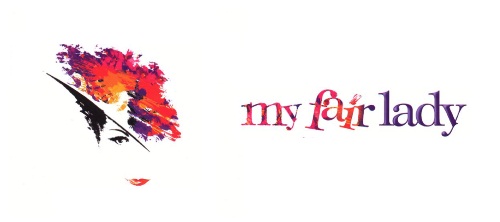
Musical
Musique: Frederik Loewe • Paroles: Alan Jay Lerner • Livret: Alan Jay Lerner • Production originale: 22 versions mentionnées
Dispo: Résumé Synopsis Commentaire Génèse Liste chansons
Genèse: In the mid-1930s, film producer Gabriel Pascal acquired the rights to produce film versions of several of George Bernard Shaw's plays, Pygmalion among them. However, Shaw, having had a bad experience with The Chocolate Soldier, a Viennese operetta based on his play Arms and the Man, refused permission for Pygmalion to be adapted into a musical. After Shaw died in 1950, Pascal asked lyricist Alan Jay Lerner to write the musical adaptation. Lerner agreed, and he and his partner Frederick Loewe began work. They quickly realized, however, that the play violated several key rules for constructing a musical: the main story was not a love story, there was no subplot or secondary love story, and there was no place for an ensemble. Many people, including Oscar Hammerstein II, who, with Richard Rodgers, had also tried his hand at adapting Pygmalion into a musical and had given up, told Lerner that converting the play to a musical was impossible, so he and Loewe abandoned the project for two years. During this time, the collaborators separated, and Gabriel Pascal died. Lerner had been trying to musicalize Li'l Abner when he read Pascal's obituary and found himself thinking about Pygmalion again. When he and Loewe reunited, everything fell into place. All the insurmountable obstacles that stood in their way two years earlier disappeared when the team realized that the play needed few changes apart from (according to Lerner) "adding the action that took place between the acts of the play". They then excitedly began writing the show. However, Chase Manhattan Bank was in charge of Pascal's estate, and the musical rights to Pygmalion were sought both by Lerner and Loewe and by MGM, whose executives called Lerner to discourage him from challenging the studio. Loewe said, "We will write the show without the rights, and when the time comes for them to decide who is to get them, we will be so far ahead of everyone else that they will be forced to give them to us". For five months Lerner and Loewe wrote, hired technical designers, and made casting decisions. The bank, in the end, granted them the musical rights. Noël Coward was the first to be offered the role of Henry Higgins but turned it down, suggesting the producers cast Rex Harrison instead. After much deliberation, Harrison agreed to accept the part. Mary Martin was an early choice for the role of Eliza Doolittle, but declined the role. Young actress Julie Andrews was "discovered" and cast as Eliza Doolittle after the show's creative team went to see her Broadway debut in The Boy Friend. Moss Hart agreed to direct after hearing only two songs. The experienced orchestrators Robert Russell Bennett and Philip J. Lang were entrusted with the arrangements and the show quickly went into rehearsal. The musical's script used several scenes that Shaw had written especially for the 1938 film version of Pygmalion, including the Embassy Ball sequence and the final scene of the 1938 film rather than the ending for Shaw's original play. The montage showing Eliza's lessons was also expanded, combining both Lerner and Shaw's dialogue. The show's title relates to one of Shaw's provisional titles for Pygmalion, Fair Eliza, and to the final line of every verse of the nursery rhyme "London Bridge Is Falling Down". The artwork on the original Playbill (and sleeve of the cast recording) is by Al Hirschfeld, who drew the playwright Shaw as a heavenly puppetmaster pulling the strings on the Henry Higgins character, while Higgins in turn attempts to control Eliza Doolittle. Original Broadway production The musical had its pre-Broadway tryout at New Haven's Shubert Theatre. On opening night Rex Harrison, who was unaccustomed to singing in front of a live orchestra, "announced that under no circumstances would he go on that night...with those thirty-two interlopers in the pit". He locked himself in his dressing room and came out little more than an hour before curtain time. The whole company had been dismissed but were recalled, and opening night was a success. The musical then played for four weeks at the Erlanger Theatre in Philadelphia, beginning on February 15, 1956. The musical premiered on Broadway March 15, 1956, at the Mark Hellinger Theatre in New York City. It transferred to the Broadhurst Theatre and then The Broadway Theatre, where it closed on September 29, 1962 after 2,717 performances, a record at the time. Moss Hart directed and Hanya Holm was choreographer. In addition to stars Rex Harrison, Julie Andrews and Stanley Holloway, the original cast included Robert Coote, Cathleen Nesbitt, John Michael King, and Reid Shelton. Edward Mulhare and Sally Ann Howes replaced Harrison and Andrews later in the run. The Original Cast Recording went on to become the best-selling album in the country in 1956. The original costumes were designed by Cecil Beaton and are on display at the Costume World Broadway Collection in Pompano Beach, Florida, along with many of the original patterns. Original London production The West End production, in which Harrison, Andrews, Coote, and Holloway reprised their roles, opened April 30, 1958, at the Theatre Royal, Drury Lane, where it ran for five and one-half years (2,281 performances). Stage star Zena Dare made her last appearance in the musical as Mrs. Higgins. 1970s revivals The first revival opened at the St. James Theatre on Broadway on March 25, 1976 and ran there until December 5, 1976; it then transferred to the Lunt-Fontanne Theatre, running from December 9, 1976 until it closed on February 20, 1977, after a total of 377 performances and 7 previews. The director was Jerry Adler, with choreography by Crandall Diehl, based on the original choreography by Hanya Holm. Ian Richardson starred as Higgins, with Christine Andreas as Eliza, George Rose as Alfred P. Doolittle and Robert Coote recreating his role as Pickering. Both Richardson and Rose were nominated for the Tony Award for Best Actor in a Musical, with the award going to Rose. A London revival opened at the Adelphi Theatre in October 1979, with Tony Britton as Higgins, Liz Robertson as Eliza, Dame Anna Neagle as Higgins' mother, Peter Bayliss, Richard Caldicot and Peter Land. Cameron Mackintosh produced with Robin Midgley directing the national tour, while Alan Jay Lerner directed into the West End. Gillian Lynne choreographed. Britton and Robertson were both nominated for Olivier Awards. 1981 and 1993 Broadway revivals A revival opened at the Uris Theatre on August 18, 1981 and closed on November 29, 1981 after 120 performances and 4 previews. Rex Harrison recreated his role as Higgins, with Jack Gwillim and Milo O'Shea co-starring and Nancy Ringham as Eliza. The director was Patrick Garland, with choreography by Crandall Diehl. Another revival opened at the Virginia Theatre on December 9, 1993 and closed on May 1, 1994 after 165 performances and 16 previews. Directed by Howard Davies, with choreography by Donald Saddler, the cast starred Richard Chamberlain, Melissa Errico and Paxton Whitehead. Julian Holloway, son of Stanley Holloway, recreated his father's role of Alfred P. Doolittle. 2001 London revival; 2003 Hollywood Bowl production Mackintosh produced a new production on March 15, 2001 at the Royal National Theatre, which transferred to the Theatre Royal, Drury Lane on July 21. Directed by Trevor Nunn, with choreography by Matthew Bourne, the musical starred Martine McCutcheon as Eliza and Jonathan Pryce as Higgins. This revival won three Olivier Awards: Outstanding Musical Production, Best Actress in a Musical (Martine McCutcheon) and Best Theatre Choreographer (Matthew Bourne), with Anthony Ward receiving a nomination for Set Design. Ironically, McCutcheon won the award despite being off sick for most of her eight-month run. In December 2001 Joanna Riding took over the role of Eliza and in May 2002 Alex Jennings took over as Higgins, both winning Olivier Awards for Best Actor and Best Actress in a Musical respectively in 2003. In March 2003, Anthony Andrews and Laura Michelle Kelly took over the roles until the show closed on August 30, 2003. A UK tour of this production began September 28, 2005. The production starred Amy Nuttall and Lisa O'Hare as Eliza, Christopher Cazenove as Henry Higgins, Russ Abbot and Gareth Hale as Alfred Doolittle, and Honor Blackman[28] and Hannah Gordon as Mrs. Higgins. The tour ended August 12, 2006. In 2003 a production of the musical at the Hollywood Bowl starred John Lithgow as Henry Higgins, Melissa Errico as Eliza Doolittle, Roger Daltrey as Alfred P. Doolittle and Paxton Whitehead as Colonel Pickering.[30]
Résumé: Henry Higgins est un illustre professeur de phonétique. Un soir, à Covent Garden, il fait la connaissance du Colonel Pickering et d'une marchande de fleurs nommée Eliza Doolittle. Elle propose au savant de l'engager pour qu'il lui enseigne les bonnes manières et la débarrasse de son accent « cockney ». Eliza pourrait ainsi améliorer sa situation sociale. Higgins accepte le défi et accueille la jeune fille chez lui. Au terme de leçons éprouvantes, Higgins emmène son élève à Ascot puis à un bal où elle est présentée à la reine. Les convives tombent sous son charme. Zoltan Karpathy, un ancien étudiant d'Higgins, affirme qu'elle appartient à la noblesse européenne. Higgins savoure sa victoire. Son attitude blesse Eliza qui trouve refuge auprès de la mère de ce dernier.
Création: 15/3/1956 - Mark Hellinger Theatre (Broadway) - 2717 représ.
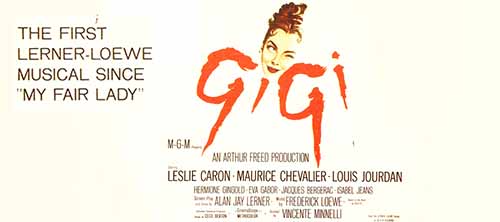
Film
Musique: Frederik Loewe • Paroles: Alan Jay Lerner • Livret: Alan Jay Lerner • Production originale: 1 version mentionnée
Dispo: Résumé Commentaire Génèse
Gigi est un film musical américain réalisé par Vincente Minnelli, avec Maurice Chevalier, Leslie Caron et Louis Jourdan. Le film fut présenté en avant-première en mai 1958 au Festival de Cannes et à New York, puis sortit aux États-Unis et à travers le monde. Il reçut de nombreux prix, dont neuf Oscars et trois Golden Globes. C'est une adaptation de la nouvelle Gigi (1944), écrite par l'écrivaine Colette.
Genèse: Le projet est initié par l'actrice Leslie Caron qui propose le sujet aux studios de la MGM avec lesquels elle est presque en fin de contrat et alors sous-employée. Le scénario de Vincente Minnelli est basé sur la nouvelle de Colette. Bénéficiant d'importants moyens, Minnelli réalise, en une suite de tableaux hauts en couleur, une reconstitution somptueuse et particulièrement soignée, voire idéalisée de la Belle Époque. Les extérieurs sont, pour la plupart, tournés à Paris : dans les célèbres jardins des Tuileries et du Luxembourg, autour des Champs-Élysées et au bois de Boulogne pour l'essentiel. La mise en scène est inspirée et brillante comme toujours chez cet artiste, à la fois peintre et cinéaste. L'interprétation est pleine d'assurance et, fait rarissime dans le cinéma hollywoodien, n'utilise que des artistes français pour incarner les personnages principaux. Le film s'ouvre et s'achève sur la célèbre chanson de Maurice Chevalier vantant la séduction des « little girls ».
Résumé: À Paris, à la Belle Époque (fiacres, premières automobiles) -Colette dans sa nouvelle précise 1899-, l'éducation de la jeune Gigi (Leslie Caron), dont la mère célibataire est accaparée par son travail de cantatrice à l'Opéra-Comique (qu'on ne voit jamais, mais on entend ses vocalises), est confiée à sa grand-mère Mamita (Hermione Gingold) -Mme Alvarez-, et à sa tante Alicia (Isabel Jeans), deux sœurs déjà âgées, qui s'avèrent être d'anciennes demi-mondaines ou cocottes, condition attribuée dans ce film -contrairement à la nouvelle- surtout à Alicia (à cette époque sans divorces et aux mariages encore souvent de raison et patrimoniaux, ces femmes, les demi-mondaines -une quasi institution au 19e siècle-, étaient les maîtresses, souvent volages ou vite délaissées, d'hommes fortunés, qui les entretenaient, parfois à grands frais). Alicia, plus riche que sa sœur Mamita, car elle a vécu très richement entretenue jadis, par plusieurs célèbres amants, concocte pour Gigi une vie galante semblable à celle qu'elle a connue. Gigi est une jeune fille de 15 ans, innocente mais délurée, fort intéressée par le beau monde et attentive aux ragots de la presse mondaine. Ses plus grandes joies sont des plaisirs simples comme les moments partagés à bavarder avec l'élégant, fort policé, et oisif jeune Gaston Lachaille (Louis Jourdan), richissime héritier d'une famille d'industriels du sucre, séducteur réputé et célébrité mondaine, qui vient pourtant régulièrement visiter l'humble famille Alvarez, fuyant ainsi un instant sa vie publique frivole -on découvrira que Mme Alarez fut jadis la maîtresse de l'oncle de Gaston (dans la nouvelle de Colette se serait le père de Gaston)-. Gaston est souvent aperçu en compagnie de ce riche oncle et mentor Honoré Lachaille (Maurice Chevalier), amateur de femmes et grande figure de la vie mondaine parisienne comme son neveu -un personnage majeur du film, qui n'existe pas dans la nouvelle de Colette, et un rôle principal, établi sur mesure pour un Maurice Chevalier vieillissant-. Sans qu'il le réalise encore, Gaston est amoureux de la toute jeune Gigi qui, de son côté, finit par tomber amoureuse de Gaston. Mais que peut espérer la fille d'une chanteuse et la petite-fille et petit-nièce de demi-mondaines ? Après avoir refusé l'offre de Gaston de lui "assurer un avenir", rebutée par la perspective d'une vie de maîtresse éphémère et probable future "demi-mondaine", au grand dam de sa tante et de sa grand-mère, Gigi s'apprête néanmoins, à contrecœur, à accepter finalement de devenir la maîtresse de Gaston, pour pouvoir vivre pleinement cet amour. Gaston se rend compte alors soudain de la profondeur de ses propres sentiments, de l'innocence de Gigi et du sacrifice de celle-ci. Et il vient alors demander, en bonne et due forme, la main de Gigi à sa grand-mère.
Création: 15/5/1958 - *** Film (***) - représ.
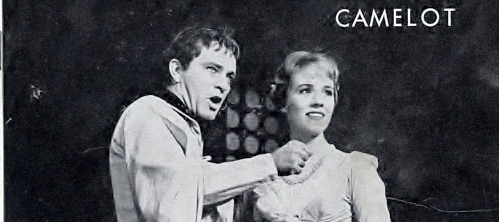
Musical
Musique: Frederik Loewe • Paroles: Alan Jay Lerner • Livret: Alan Jay Lerner • Production originale: 22 versions mentionnées
Dispo: Résumé Synopsis Génèse Isnpiration Liste chansons
As the immediate successor of My Fair Lady -- and with so many of the collaborators who had made My Fair Lady an unforgettable stage experience -- a good deal was expected of Camelot when it arrived on Broadway. It achieved the unprecedented advance sales of three and a half million dollars, and forthwith was sold to the motion pictures for three million dollars more. But while Camelot was no My Fair Lady -- and thus aroused a good measure of disappointment among the critics -- it was nevertheless a musical play with many moments of enchantment and with some of the most handsomely mounted sets Broadway had seen in many a year.
Genèse: In 1959, Alan Jay Lerner and Moss Hart decided to adapt T. H. White's The Once and Future King as their next project. As discussed in Lerner's 1978 book, The Street Where I Live, Frederick Loewe, who had no interest in the project, agreed to write music, with the understanding that if things went badly, it would be his last score. After the tremendous success of My Fair Lady, expectations were high for a new Lerner and Loewe musical. However, the show's production met several obstacles. Lerner's wife left him during the writing process, causing him to seek medical attention and delaying the production. When Camelot began rehearsals, it still needed considerable work. However, the producers were able to secure a strong cast including Julie Andrews, Richard Burton and Roddy McDowall, as well as Robert Goulet in his first Broadway role. John Cullum also made his Broadway debut as Sir Dinadan; Bruce Yarnell was Sir Lionel. Cullum later replaced McDowall, and William Squire replaced Burton. Other replacements included Patricia Bredin, Kathryn Grayson and Janet Pavek for Andrews. The show's first tryout was in Toronto, at the O'Keefe Centre in 1960. The curtain came down at twenty minutes to one in the morning; Lerner later noted that "Only Tristan and Isolde equaled it as a bladder endurance contest." The morning papers, though kind, hinted that the show needed much work in order to succeed. Lerner was hospitalized with a bleeding ulcer and had to withdraw from preparations for a time. Hart then suffered a heart attack, and Lerner stepped in as temporary director for the rest of the out-of-town run at the behest of Kitty Carlisle Hart. Camelot then moved to Boston, nearly an hour and a half shorter, but still running very long. The production team tried to find another director, even phoning Jose Ferrer, who could not undertake the job. Lerner and Loewe disagreed on how to proceed with the show, as Loewe did not want to make any major changes without Hart's guidance. Lerner wrote: "God knows what would have happened had it not been for Richard Burton." Accepting cuts and changes, he radiated a "faith and geniality" and calmed the fears of the cast. Guenevere's song "Before I Gaze at You Again" was given to Andrews at the last minute before the first New York preview, which provoked her famous quote, "Of course darling, but do try to get it to me the night before." After the show opened on Broadway, Hart was released from the hospital, and he and Lerner began cutting the play even further. Two songs, "Then You May Take Me To the Fair" and "Fie on Goodness," were cut a few months into the run (though they remain on the cast album). The advance sale for the show was the largest in Broadway history. The New York critics' reviews of the original production were mixed. Fortunately for the show, Ed Sullivan approached Lerner and Loewe to create a segment for his television variety program, celebrating the fifth anniversary of My Fair Lady. They decided to do very little from their previous hit and instead to perform four highlights from Camelot. The show stimulated ticket sales, and Camelot achieved an unprecedented advance sale of three and a half million dollars. It was also publicized, just after the assassination of President John F. Kennedy (a classmate of Lerner at Harvard), that the show's original cast recording had been favorite bedtime listening in the White House, and that Kennedy's favorite lines were in the final number (in which Arthur knights a young boy and tells him to pass on the story of Camelot to future generations): Don't let it be forgot That once there was a spot, For one brief, shining moment That was known as Camelot. Since then, Camelot has been associated with the Kennedy Administration. The obstacles encountered in producing Camelot were hard on the creative partnership of Lerner and Loewe, and the show turned out to be one of their last collaborations (although they did work together to adapt their 1958 movie "Gigi" to the stage in 1973, and collaborated again the following year on the movie musical "The Little Prince). Camelot was Hart's last Broadway show. He died of a heart attack in Palm Springs, California on December 20, 1961. 1960 - Broadway Camelot opened on Broadway at the Majestic Theatre on December 3, 1960 and closed on January 5, 1963 after 873 performances and 2 previews. Directed by Moss Hart, the choreography was by Hanya Holm, scenic design by Oliver Smith, costume design by Adrian (who worked on the designs prior to his death in September 1959) and Tony Duquette, and lighting design by Feder. It won four Tony Awards. The original cast album was America's top-selling LP for 60 weeks. US Tour A two-year U.S. tour followed the Broadway closing, starring Kathryn Grayson and William Squire, who was succeeded by Louis Hayward. There was also a 1963–64 bus-and-truck tour starring Biff McGuire as Arthur, Jeannie Carson as Guenevere, and Sean Garrison as Lancelot. Yet another company toured with the show in 1964, starring Howard Keel as Arthur, Constance Towers as Guenevere, and Bob Holiday as Lancelot. An Australian production opened in Adelaide in October 1963 produced by the J. C. Williamson company and ran for two years. 1964 - London The London production opened in August 1964 at the Theatre Royal, Drury Lane and featured Laurence Harvey as Arthur, Elizabeth Larner as Guenevere and Barry Kent as Lancelot. It played for 518 performances. The film version was made in 1967 starring Richard Harris and Vanessa Redgrave. Revivals Richard Burton reprised his role as Arthur in a revival that ran from July 8, 1980 to August 23, 1980 at the New York State Theater at Lincoln Center. Christine Ebersole played Guenevere, and Richard Muenz was Lancelot. The show was revived on Broadway at the Winter Garden Theater from November 15, 1981 to January 2, 1982, and broadcast on HBO a year later, starring Richard Harris as Arthur, Meg Bussert as Guenevere, and Muenz as Lancelot. Harris, who had starred in the film, and Muenz also took the show on tour nationwide. Another Broadway revival ran from June 21, 1993 to August 7, 1993 for 56 performances at the George Gershwin Theatre, with Goulet now cast in the role of Arthur. Goulet reprised this role at Toronto's O'Keefe Centre in 1993. An 18-month U.S. tour, starring Michael York as Arthur, Rachel York (no relation) as Guenevere, and James Barbour as Lancelot, began on January 9, 2007 and ended in April 2008. Alan Jay Lerner's son, Michael Lerner, contributed changes to the libretto, and Glenn Casale directed. From June 27–30, 2007, the tour played at Toronto's Hummingbird Centre, where the musical had premiered in 1960. While the 2007 Michael York tour was performing across the U.S., Candlewood International ran a separate, largely non-equity national tour that played to cities not visited by the union tour. The Morgan Le Fey sub-plot was removed. Jeff Buchsbaum directed and Paula Sloan choreographed a cast headed by Robert Brown as Arthur, Matthew Posner as Lancelot, Mollie Vogt-Welch as Guenevere and Heather Stricker as Lady Catherine. From May 7 to May 10, 2008, the New York Philharmonic presented five semi-staged concerts of Camelot directed by Lonny Price and produced by Thomas Z. Shepard and starring Gabriel Byrne as King Arthur, Marin Mazzie as Guenevere, and Nathan Gunn as Lancelot. It featured Christopher Lloyd as Pellinore, Marc Kudisch as Lionel, Bobby Steggert as Mordred, Will Swenson as Sagramore, Christopher Sieber as Dinadan and Fran Drescher as Morgan le Fey. The May 8 performance was broadcast nationally on Live from Lincoln Center on PBS.
Résumé: Le mariage arrangé entre le Roi Arthur et Guenièvre se transforme en véritable romance. Le couple s’épaule alors pour organiser l’union du royaume et établir des règles de conduite pour une chevalerie plus civilisée. Mais le regroupement d’homme d’exception amène le fier Lancelot Du Lac à la table ronde du château de Camelot…
Création: 3/12/1960 - Majestic Theatre (Broadway) - représ.

Musical
Musique: Burton Lane • Paroles: Alan Jay Lerner • Livret: Alan Jay Lerner • Production originale: 5 versions mentionnées
Dispo: Résumé Synopsis Génèse Liste chansons
Genèse: The Broadway production opened at the Mark Hellinger Theatre on October 17, 1965 and closed on June 11, 1966 after 280 performances and 3 previews. The production was directed by Robert Lewis, choreographed by Herbert Ross, and starred Barbara Harris as Daisy Gamble/Melinda, John Cullum as Dr. Mark Bruckner, Clifford David as Edward Moncrief, Titos Vandis as Themistocles Kriakos, and William Daniels as Warren Smith. Scenic design was by Oliver Smith and costume design was by Freddy Wittop. The show was not well received. Ben Brantley of the New York Times recalled: "Its book was strained and muddled, most critics agreed; its big production numbers were simply cumbersome. But it did have [a] lushly melodic score...." Tours followed starring Tammy Grimes, Linda Lavin, Van Johnson and Nancy Dussault. In February 2000, the City Center Encores! series presented a staged concert starring Kristin Chenoweth as Daisy/Melinda and Peter Friedman as Dr. Bruckner. The show premiered in London in 2000 at the Bridewell Theatre. A 1970 film adaptation directed by Vincente Minnelli starred Barbra Streisand, Yves Montand, and Jack Nicholson. A revised Broadway production began previews on November 12, 2011 at the St. James Theatre and opened on December 11, 2011, directed by Michael Mayer and with a new book by Peter Parnell. Harry Connick Jr. starred as Dr. Mark Bruckner.[5][6] The cast included Jessie Mueller as Melinda and David Turner as David Gamble. The revised version, which had a developmental workshop at The Vineyard Theatre in the fall of 2009[5]and had readings in August 2010 at the Powerhouse Theater at Vassar College, departed from the plot of the original. The patient is now a gay florist David (Turner) who was a female jazz singer Melinda (Mueller) in a former life, and who falls in love with his psychiatrist, widower Dr. Mark Bruckner (Connick). The Vassar concert mixed "material from the stage and film versions and eliminates overstuffed 1960s-style production numbers."[8] This production closed on January 29, 2012 after 29 previews and 57 performances.
Résumé: Daisy Gamble has some unusual powers like hearing phones before they ring and making flowers grow just by talking to them. However, she thinks she’s just a normal person. In fact, her primary concern is trying to quit smoking in order to please her fiancé. To accomplish this goal, she seeks the help of a hypnotist, Mark Bruckner. During their sessions, Mark discovers that she can regress into past lives and different personalities. Mark ends up falling in love with one of Daisy’s personalities, ‘Melinda’. In the end, Daisy finally realizes how special she realy is.
Création: 17/10/1965 - Mark Hellinger Theatre (Broadway) - représ.
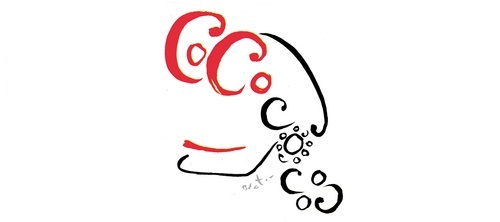
Musical
Musique: André Previn • Paroles: Alan Jay Lerner • Livret: Alan Jay Lerner • Production originale: 2 versions mentionnées
Dispo: Résumé Synopsis Génèse Liste chansons
Genèse: Theatre producer Frederick Brisson originally had optioned Chanel's life for his wife Rosalind Russell, but Russell had developed acute arthritis, making it difficult for her to function. That meant another leading lady with star quality needed to be found. Irene Selznick suggested Katharine Hepburn, who initially scoffed at the idea of appearing in a musical but agreed to work with former MGM vocal coach Roger Edens for ten days. Following an audition in Selznick's suite at The Pierre Hotel, Hepburn felt comfortable enough to mull seriously the proposition, and was further convinced to accept the offer after meeting Chanel. Lerner had assured the designer his book would cover only the early years of her life and career, and she was distressed when the plan was jettisoned to accommodate the older star. The highly fictionalized book and score underwent massive revisions and were far from complete when Hepburn concluded filming on The Madwoman of Chaillot, at which time she was scheduled to begin work on the show, and Coco was postponed a season while its creators worked on it. The six-week rehearsal period finally began in September 1969. Cecil Beaton's set proved to be a complicated piece of machinery that frequently malfunctioned and was difficult for the cast to maneuver, and the final scene required a troublesome coordination of mirrors, platforms, runways, and flashing lights. Hepburn insisted the theater's thermostat be set at 60 degrees and the exterior doors left open, and most of the cast became ill due to the unusually cold fall weather. After 40 previews, the Broadway production opened on December 18, 1969 at the Mark Hellinger Theatre, where it ran for 329 performances. Directed by Michael Benthall and choreographed by Michael Bennett, the cast included René Auberjonois, George Rose, Michael Allinson, David Holliday, Bob Avian, Jon Cypher, Suzanne Rogers, Graciela Daniele, Ann Reinking, and Gale Dixon. Danielle Darrieux replaced Hepburn eight months into the run, but without the drawing power of a major star the poorly reviewed show closed two months later. Hepburn was scheduled to star in a West End production, but when the Theatre Royal, Drury Lane proved to be unavailable she refused to consider other venues and the project was abandoned. She headed the cast of the US national tour, which opened in Cleveland on January 11, 1971, the day after Chanel's death, which the star acknowledged at the final curtain call. She continued with the tour through June, when it ended at the Dorothy Chandler Pavilion in Los Angeles. Although reviews in most cities were mediocre, it played to sold-out houses everywhere. Despite its financial success, executives at Paramount Pictures, which had financed the original Broadway production - at $900,000, the most expensive show in Broadway history at the time - in exchange for the cast album and film rights, opted not to transfer Coco to the big screen. Coco was produced as a staged concert 42nd Street Moon in San Francisco in April and May 2008, starring Andrea Marcovicci in the title role. The production played for a total of 16 performances. It was directed by Mark D. Kaufmann and choreographed by Jayne Zaban. Marcovicci revisited the role in September 2010 for the show's first New York revival as part of the York Theatre Company's Musicals in Mufti.
Résumé: Set between early autumn of 1953 and late spring of 1954, fashion designer Coco Chanel, after fifteen years of retirement, decides to return to the world of haute couture and reopen her Paris salon. With her new collection derided by the critics, she faces bankruptcy until buyers from four major American department stores - Saks Fifth Avenue, Bloomingdale's, Best & Company, and Ohrbach's - place orders with her. She becomes involved with the love life of one of her models, and flashbacks utilizing filmed sequences recall her own past romantic flings. Adding humor to the proceedings is a highly stereotypical rude gay designer who tries to impede Chanel's success.[2] The finale is a fashion show featuring actual Chanel designs from 1918 to 1959.
Création: 18/12/1969 - Mark Hellinger Theatre (Broadway) - représ.

Musical
Musique: John Barry • Paroles: Alan Jay Lerner • Livret: Alan Jay Lerner • Production originale: 2 versions mentionnées
Dispo: Commentaire Génèse Liste chansons
Genèse: Lolita, My Love was initiated by Lerner, the well-known lyricist of My Fair Lady and other major hits, who recruited Barry to write the score. Nabokov, who had several times refused to allow adaptations of his novel, stated that "Mr. Lerner is a most talented and excellent classicist. If you have to make a musical version of Lolita, he is the one to do it."[1] Like most musicals of the time, the production was scheduled for a multi-city "tryout" tour, during which rewrites could be done as needed, before opening on Broadway. The original director was opera impresario Tito Capobianco, and choreography was provided by Jack Cole, although Cole was fired during rehearsals and replaced by Danny Daniels. Upon opening in Philadelphia on February 16, 1971, the show got savage reviews and immediately closed for more work. Capobianco was fired and replaced by Noel Willman, and Daniels was replaced as choreographer by Dan Siretta. Even the actress playing Lolita was let go. The show reopened in Boston but did lukewarm business and received mixed reviews, although critics acknowledged good performances by John Neville as Humbert and Dorothy Loudon as Lolita's vulgar mother, Charlotte, and found the music and lyrics strong. Lolita was played by actress Denise Nickerson, and Oscar Nominee Leonard Frey was Claire Quiltey. The production closed before its scheduled opening at the Mark Hellinger Theatre, the site of many previous Lerner triumphs; it lost $900,000.
Résumé:
Création: 16/2/1971 - * Fermé en Try-Out () - 0 représ.
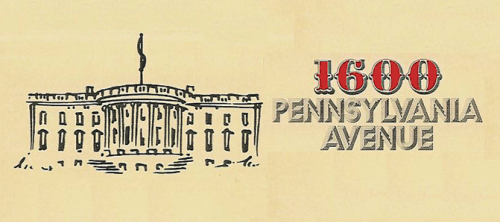
Musical
Musique: Leonard Bernstein • Paroles: Alan Jay Lerner • Livret: Alan Jay Lerner • Production originale: 1 version mentionnée
Dispo: Synopsis Génèse Liste chansons
Genèse: The musical opened on May 4, 1976 at the Mark Hellinger Theatre and closed on May 8, 1976 after 7 performances and 13 previews. It was co-directed and co-choreographed by Gilbert Moses and George Faison. The musical examined the establishment of the White House and its occupants from 1800 to 1900. Primarily focusing on race relations, the story depicted (among other incidents) Thomas Jefferson's then-alleged affair with a black maid, James Monroe's refusal to halt slavery in Washington, the aftermath of the American Civil War and Andrew Johnson's impeachment. Throughout the show, the leading actors performed multiple roles: Ken Howard played all the presidents, Patricia Routledge all the First Ladies, and Gilbert Price and Emily Yancy played the White House servants, Lud and Seena. Future Broadway stars Reid Shelton, Walter Charles, Beth Fowler and Richard Muenz appeared in ensemble roles, as did the young African American baritone Bruce Hubbard. The show was originally intended to be performed as a play-within-a-play, with the show's actors stepping out of character to comment on the plot and debate race relations from a modern standpoint. But this concept was almost entirely removed during the show's out-of-town tryouts in Philadelphia and Washington, D.C. The musical's original director, Frank Corsaro, choreographer, Donald McKayle, and set and costume designer, Tony Walton, left the production during these try-outs. By the time the show opened on Broadway, little of the metatheatrical concept remained, aside from certain scenic and costume elements and a few musical references (most notably, the opening number "Rehearse!"). Discouraged by the critical and public response to the work and angry that during the tryouts much of his music had been condensed and edited without his consent, Bernstein refused to allow a cast recording of the musical. Critical reaction The initial critical response to the show was resoundingly negative. Critics savaged Lerner's book while largely praising Bernstein's score. Only Patricia Routledge was spared, thanks mostly to her second act showstopper "Duet for One (The First Lady of the Land)" for which she received a mid-show standing ovation on opening night in New York. After Bernstein's death a concert version of the score, retitled A White House Cantata was recorded and released. That version tended to be reviewed as a classical work rather than a Broadway musical, a tendency encouraged by the casting of the leading roles with opera singers. Differences in the score and performance style make it impossible to judge the original musical fairly from the later recording. The score is considered by many musical theater historians and aficionados to be a forgotten, or at least neglected, masterpiece. Some of the songs have enjoyed some fame outside the show including "Take Care of This House," "The President Jefferson Sunday Luncheon Party March" and "Duet for One", a tour-de-force for a single actress portraying both Julia Grant and Lucy Hayes on the day of Rutherford B. Hayes's inauguration detailing the exhausting vote counts that had many questioning his legitimacy. Author Ethan Mordden noted that "Bernstein and Lerner created an astonishingly good score, even a synoptic all-American one, with fanfare, march, waltz, blues. It's Bernstein's most classical work for Broadway." Reuse of material in other works As with his previously abandoned projects, Bernstein used portions of the score in subsequent works. In Songfest, for example, the setting of Walt Whitman's poem "To What You Said" as a baritone solo was a reworking of the original prelude of the show, in which the chorus hummed a melody played by the violoncello in the Songfest version. (In the show, this music was moved to the emotional low point of the second act, used as background to a Presidential funeral.) The occasional piece Slava! A Political Overture, written in honor of Bernstein's friend Mstislav Rostropovich, blended two numbers from the show, the up-tempo "Rehearse!" and "The Grand Old Party." Early in the opera A Quiet Place, the music for the aria "You're late, you shouldn't have come" derives from that of "Me," a song that in the original show established the meta-theatrical concept that was eventually abandoned. (Some of the music for "Me" can be heard in the Broadway score, most memorably in the song "American Dreaming.") An instrumental section of "The President Jefferson March" was reused in the final movement, "In Memoriam and March: The BSO Forever," of the Divertimento. Subsequent revivals The show's only significant revival was a 1992 Indiana University Opera Theatre production, which used a pre-Philadelphia draft of the script and included portions of Bernstein's music that had been excised on the road to Broadway. This production also played briefly at the Kennedy Center in Washington, D.C. in August 1992. A White House Cantata After his death in 1990, Bernstein's children and associates sifted through the many variations and revisions of the score and authorized a choral version entitled A White House Cantata, which deleted nearly all the remaining play-within-a-play references. (Some can still be heard in the duet "Monroviad.") BBC Radio broadcast the London debut of this work in 1997, and three years later Deutsche Grammophon released an abridged performance in a CD recording. Both the London concert and the DG recording were conducted by Kent Nagano with the London Symphony Orchestra. The Leonard Bernstein estate controls the licensing of performances of the cantata version, but refuses to allow the performance, recording, or publication of the original musical.
Résumé:
Création: 4/5/1976 - Mark Hellinger Theatre (Broadway) - 7 représ.

Musical
Musique: Charles Strouse • Paroles: Alan Jay Lerner • Livret: Alan Jay Lerner • Production originale: 1 version mentionnée
Dispo: Résumé Synopsis Génèse Isnpiration Liste chansons
Genèse: The musical opened on Broadway at the Minskoff Theatre on May 11, 1983, where it closed after one performance and twenty-five previews. Directed by Lerner and choreographed by Billy Wilson, the cast included Len Cariou, Liz Robertson, George Rose, Don Chastain, Brent Barrett, and Alyson Reed. Showbusiness insiders dubbed it "Dance a Little Faster...Close a Little Sooner." In his New York Times review Frank Rich described it as "a huge, extravagant mishmash . . . that seems to have taken on a rampaging, self-destructive life of its own," a sentiment similar to those expressed by the other critics. An original cast recording is available on CD.
Résumé: Harry Aikens, a down-at-heel supper club entertainer warms again to an old flame, Cynthia Brookfield-Bailey, when they are both ensconced in an Austrian hotel on New Year's Eve awaiting World War III. Cynthia was the mistress of a man who bore a remarkable resemblance to the American diplomat, Henry Kissinger.
Création: 11/5/1983 - Minskoff Theatre (Broadway) - représ.

Version 1
Camelot (1960-10-O'Keefe Center-Toronto)
Type de série: Pre-Broadway Try OutThéâtre: Sony Centre for Performing Arts (Toronto - Canada) Durée : 3 semaines Nombre : Première Preview : Saturday 01 October 1960Première : Saturday 01 October 1960Dernière : Saturday 22 October 1960Mise en scène : Alan Jay Lerner • Moss Hart • Chorégraphie : Hanya Holm • Producteur : Avec : Arthur … Richard Burton
Guenevere … Julie Andrews
Lancelot Du Lac … Robert Goulet
King Pellinore … Robert Coote
Sir Dinadan … John Cullum
Mordred … Roddy McDowall
Merlyn … David Hurst
Morgan Le Fey … M'el Dowd
Sir Lionel … Bruce YarnellCommentaires longs: C'est avec ce spectacle qu'à ouvert le O'Keefe Center à Toronto (actuellement renommé le Sony Center for Performing Arts).
The first performance during the out-of-town tryout lasted until 12:30am. Alan Jay Lerner later said, "Only Tristan and Isolde equaled it as a bladder endurance contest."
During the pre-Broadway Toronto run, Alan Jay Lerner was hospitalized with a bleeding ulcer and had to withdraw from work on the show for a time during tryouts. Moss Hart suffered a heart attack and Lerner took over as director.

Version 2
Camelot (1960-10-Shubert Theatre-Boston)
Type de série: Pre-Broadway Try OutThéâtre: Shubert Theatre (Boston - Etats-Unis) Durée : Nombre : Première Preview : InconnuPremière : Tuesday 25 October 1960Dernière : InconnuMise en scène : Alan Jay Lerner • Moss Hart • Chorégraphie : Hanya Holm • Producteur : Avec : Arthur … Richard Burton
Guenevere … Julie Andrews
Lancelot Du Lac … Robert Goulet
King Pellinore … Robert Coote
Sir Dinadan … John Cullum
Mordred … Roddy McDowall
Merlyn … David Hurst
Morgan Le Fey … M'el Dowd
Sir Lionel … Bruce YarnellCommentaires longs: During the pre-Broadway Toronto run, Alan Jay Lerner was hospitalized with a bleeding ulcer and had to withdraw from work on the show for a time during tryouts. Moss Hart suffered a heart attack and Lerner took over as director. In Boston, the running time was shortened by an hour and a half but Lerner was still looking for a new director. He went so far as to ask José Ferrer, but Ferrer declined.
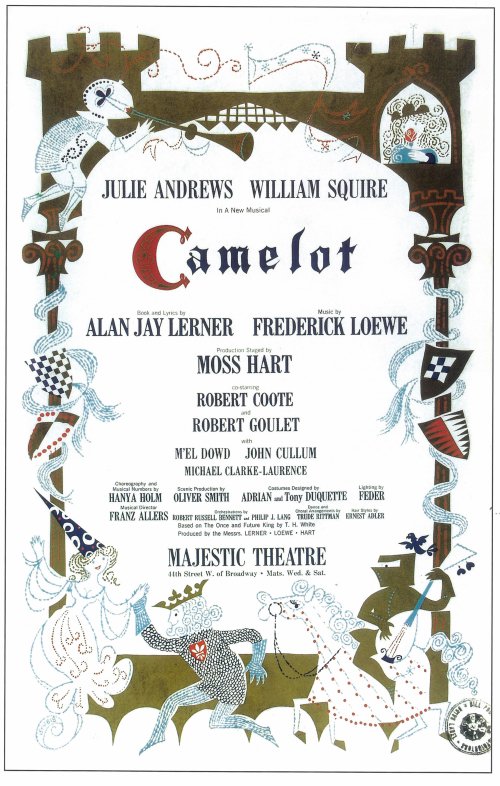
Version 3
Camelot (1960-12-Majestic Theatre-Broadway)
Type de série: Original BroadwayThéâtre: Majestic Theatre (Broadway - Etats-Unis) Durée : 2 ans 1 mois Nombre : 2 previews - 873 représentationsPremière Preview : Thursday 01 December 1960Première : Saturday 03 December 1960Dernière : Saturday 05 January 1963Mise en scène : Alan Jay Lerner • Moss Hart • Chorégraphie : Hanya Holm • Producteur : Avec : Arthur … Richard Burton
Guenevere … Julie Andrews
Lancelot Du Lac … Robert Goulet
King Pellinore … Robert Coote
Sir Dinadan … John Cullum
Mordred … Roddy McDowall
Merlyn … David Hurst
Morgan Le Fey … M'el Dowd
Sir Lionel … Bruce YarnellCommentaires longs: One of the most torturous rehearsal and tryout periods for a Broadway musical. Costume designer Adrian died before opening. Director/producer Moss Hart had a heart attack on the tryout tour resulting in Alan Jay Lerner taking over direction.

Version 4
Camelot (1963-01-US Tour 1)
Type de série: US TourThéâtre: US Tour ( - Etats-Unis) Durée : Nombre : Première Preview : InconnuPremière : Tuesday 08 January 1963Dernière : InconnuMise en scène : Alan Jay Lerner • Moss Hart • Chorégraphie : Hanya Holm • Producteur : Commentaires longs: Opened at the Fisher Theatre in Detroit

Version 5
Dance a Little Closer (1983-04-Minskoff Theatre-Broadway)
Type de série: OriginalThéâtre: Minskoff Theatre (Broadway - Etats-Unis)
Durée : Nombre : 25 previews - 1 représentationsPremière Preview : Saturday 16 April 1983Première : Wednesday 11 May 1983Dernière : Wednesday 11 May 1983Mise en scène : Alan Jay Lerner • Chorégraphie : Billy Wilson • Producteur : Avec : Harry Aikens … Len Cariou
Cynthia Brookfield-Bailey … Liz Robertson
Dr. Josef Winkler … George Rose
Charles Castleton … Brent Barrett
Ice Skater … Colleen Ashton
Roger Butterfield … Don Chastain
Captain Meuller … Noel Craig
Rink Attendant … James Fatta
Reverend Oliver Boyle … I.M. Hobson
Contessa Carla Pirianno … Elizabeth Hubbard
Edward Dunlop … Jeff Keller
Heinrich Halloway … Joseph Kolinski
Bellboy … Philip Mollet
Johannes Hartog … Reuben Singer
Waiter … Brian Sutherland
Hester Boyle … Joyce Worsley
Violinist … James Fatta
Harry … Philip Mollet
Cynthia's Double (Pas de deux) … Robin Stephens
Harry's Double (Pas de deux) … Brian Sutherland
Harry … Peter Wandel
A Rich Man … James Fatta
Bebe (The Delights) … Cheryl Howard
Shirley (The Delights) … Diane Pennington
Elaine (The Delights) … Alyson Reed

.png)
.png)





